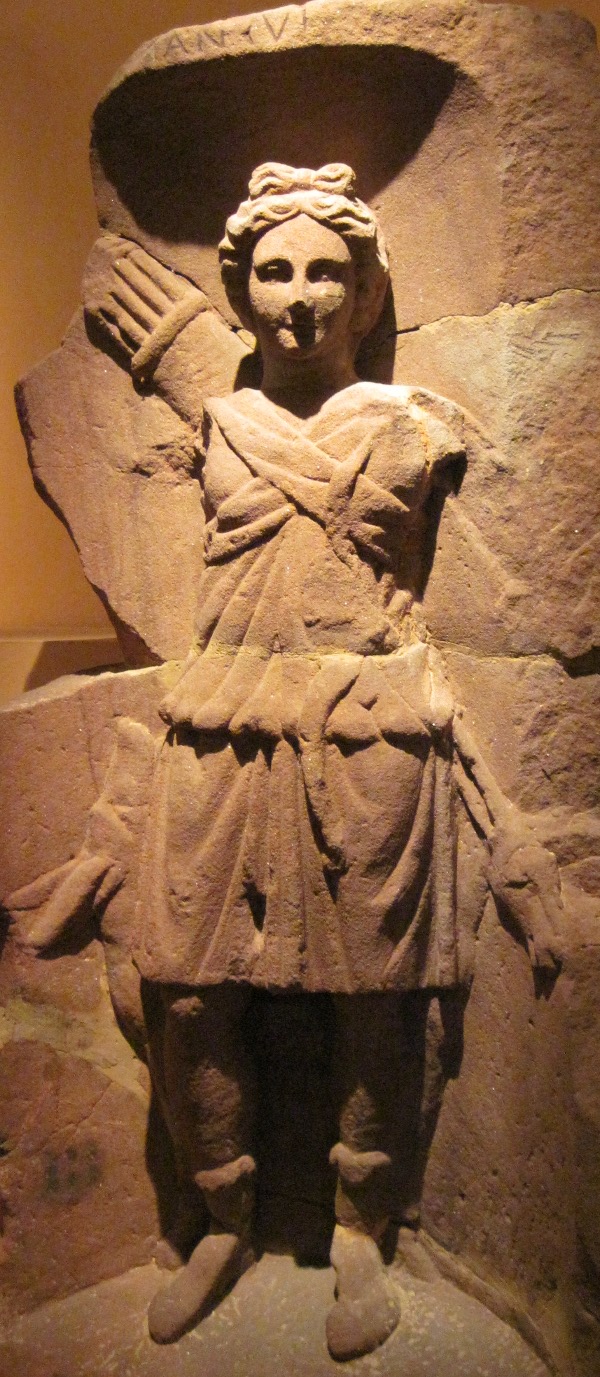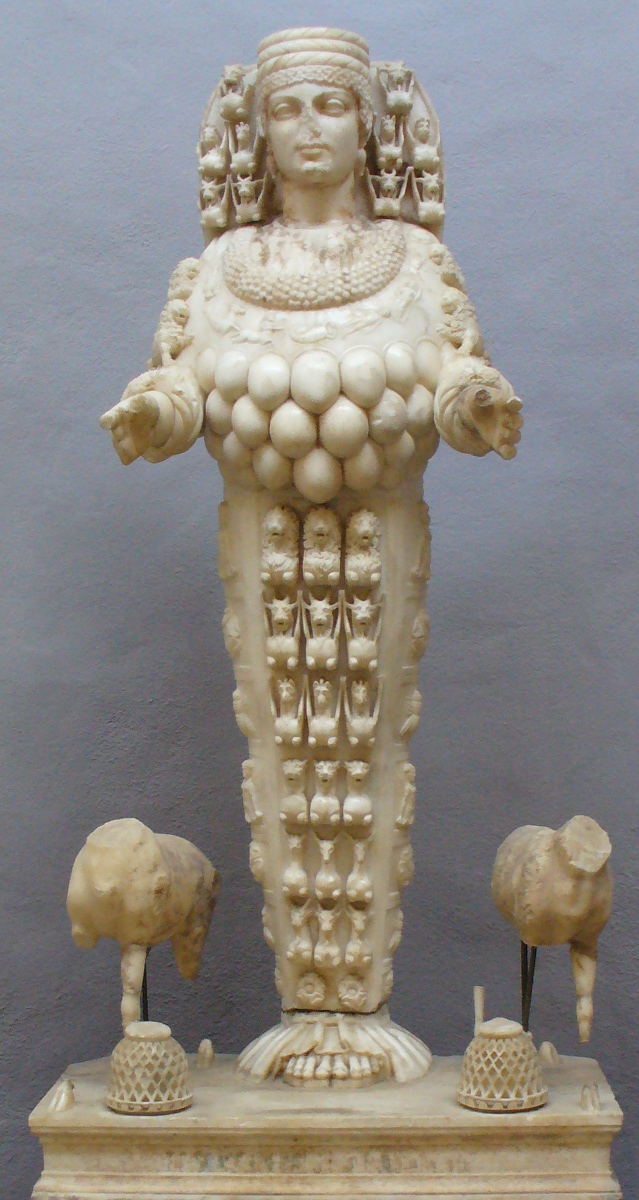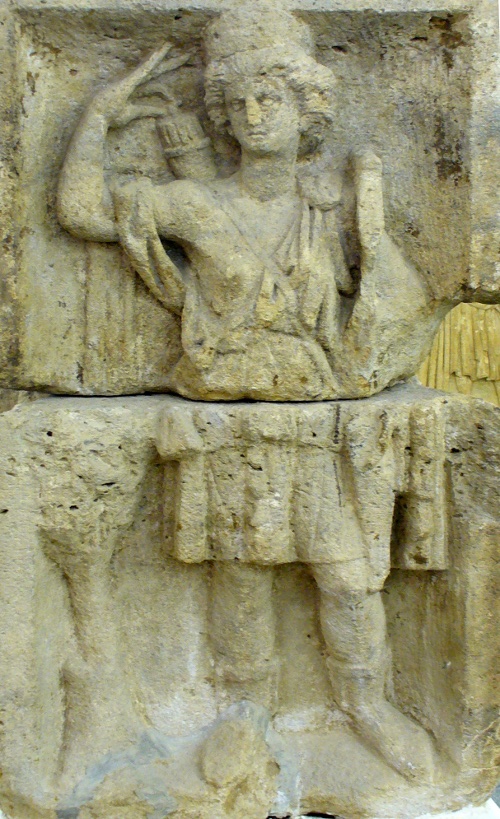
A sublime relief of Diana, found at Waldfischbach-Burgalben. Here we have a young and lively looking Diana, carrying arrows and accompanied by a deer (unfinished).
(Historisches Museum der Pfalz, Speyer; 3rd century CE)
Diana of Ephesus and of the Aventine · Abnoba · Luna

Whether as an intrepid huntress, a confirmed virgin, a moon-goddess and a protector of pregnant women, Diana has an allure all her own. At the same time, she is a goddess whose historical importance is out of the ordinary on more than one account. The Gauls were highly faithful to her; they identified with her the deities of several important places, such as Abnoba (goddess of the Black Forest ridge where the Danube rises).
Diana’s twin brother is Apollo, who shares with her a talent for archery, a certain androgyny, and celestial associations (with the Sun in Apollo’s case, with the Moon in Diana’s). Their parents are Jupiter and Latona (a goddess greatly worshipped in Lycia, but relatively little elsewhere). According to the myth, Juno had forbidden the Earth to give Latona any place to give birth, so that the hapless mother had to flee to Delos—an island that had floated till then without being anchored to the Earth.
Unlike her brother, Diana chose a virginity that became proverbial with her. Still, a few episodes may attenuate our notions of Diana’s chastity. According to one tradition, she fell in love with the hunter Orion and would have married him but for his accidental death.[1] Some evidence suggests that the ancient Latins had considered her the partner of Janus. Diana of Ephesus, an important aspect of the goddess that we shall say more of later, is thought to represent a fertility goddess of the Anatolian mother-goddess type. Diana is attended by a train of nymphs who, like her, are virgin huntresses (they are said to frequent the mountains of Arcadia in particular). Diana adopted men’s clothes and habits, and loves women’s company; while she might not actually be a lesbian, she would have trouble convincing the attendees of an LGBTQ rally of that.
In Gaul, Diana’s cult frequently associates her with her brother Apollo. They are depicted together on many Jupiter–giant columns and inscriptions. One inscription at Augsburg jointly invokes Apollo, his partner Sirona and Diana.[2] Other inscriptions invoke Diana with her father Jupiter, with Minerva,[3] with the Capitoline Triad as a whole, with Mars, etc. But the god with whom Diana is in closest communion seems to be Silvanus. Like her, Silvanus presides over forests and wild places. Their cults also share a relatively popular social profile; both can appear as protectors of the common people. Diana’s other particular ‘colleague’ is Hercules, with whom Diana Nemorensis shared a feast day at Rome (13 August); both were deities of strength and perseverance in their respective domains.
Two inscriptions in Lower Germania also associate Diana with Nemesis—perhaps in echo of the myths portraying a vengeful Diana, like those of Niobe or the Calydonian Boar. (By the bye, the ancient Nemesis had rather a positive character; she might be, shall we say, the patron deity of an Elie Wiesel or a Human Rights Watch.) Ancient scholars identified Diana with the moon-goddess Luna, a matter we shall return to below.
Diana sometimes has a boyish appearance; her twin Apollo can also have an androgynous appearance. Like him, Diana can often be recognized by her bow and arrow. Her favourite animal is the deer (including does at times as well as stags), but all wild animals are under her protection, from hounds and boars to hares and otters, even bees and fish. The tree sacred to her is the pine. Among the animals sacrificed to her were the deer, the dog and the goat.[4]
Great is Diana of the Ephesians! [...] What man is there that knoweth not how that the city of the Ephesians is a worshipper of the great goddess Diana, and of the image which fell down from Jupiter?
—Luke, Acts[5]
The cult of Diana of Ephesus has an importance all its own in the Mediterranean world. It also has particular implications for Gaul.

Asia Minor—the Asian part of modern-day Turkey—was particularly noted for its devotion to ‘mother-goddess’ cults. As links with the Greek world grew, such goddesses were identified with various classical goddesses: Cybele in Phrygia, Venus at Aphrodisias ... and Diana at Ephesus. Now, Ephesus is on the Ægean coast of Asia Minor in a region called Ionia. There were, in this region, many cities of great renown (Miletus, Samos, Smyrna, Priene, Didyma, Teos, etc.), but none had a sanctuary that could compare to that of Diana at Ephesus. The Artemision, as it was called, was classed as one of the seven wonders of the world. The goddess was worshipped there in an extraordinary form, covered with breasts as well as small animals. She gained incomparable local prestige, which naturally extended to Phocæa just a little to the north.
So it was that when the Phocæans, expelled from their homeland, arrived on the southern coast of Gaul to found the city of Marseille, they established the cult of Diana of Ephesus in their new colony. This may well have been one of the first Hellenistic deities that the Gauls had a good chance to get to know. Commercial contacts and political links would undoubtedly have won fame for Diana of Ephesus among the peoples surrounding Marseille as well as in the interior. (Compare the analogous impression that Minerva made upon Catumandus.)
Several centuries later, armed Gaulish tribes poured into the eastern Hellenistic world, settling in Asia Minor in 278 bce to become the people known to history as the Galatians. There, they freely adopted the religion of the peoples they conquered (Phrygians, Greeks and remnants descended from the Hittites), in particular the cults of Anatolian mother-goddesses. According to Plutarch, the Galatians “worship[ped] Diana more any other deity”. The Galatian princess Camma was a priestess of Diana; it was in fact before the altar of Diana that Camma avenged her husband’s death in a famous murder-suicide.[6] In observance of a religious taboo, the Galatians of Pessinus—the holy city of Cybèle—even gave up the eating of pork[7] (a staple of the Gauls in Europe).
The Italian Diana was given the same mythology as her Greek counterpart Artemis, with certain local particularities. Diana’s chief holiday at Rome, celebrated on 13 August, was called the Nemoralia after Lake Nemi near the town of Aricia. This is a picturesque volcanic lake, endowed with a highly prestigious sanctuary. Referring to the goddess of this location, the Romans often spoke of Diana Aricina or Diana Nemorensis.
In Rome, Diana possessed a temple on the Aventine. This was one of the most important temples in Rome on account of its age, its enviable location, and its influence on provincial ritual. The Aventine’s situation facing the Palatine made it a traditional place of refuge for plebeians. The temple was built with the participation of Latin peoples allied with Rome, and the regulations for worship there were subsequently taken as a model for other temples, such as that dedicated to the numen of Augustus at Narbo.[8]
These places of worship—the Aventine and Lake Nemi—highlight Diana as a protector of refugees. The plebs sought refuge on the Aventine in 449 bce in a kind of general strike avant la lettre. Furthermore, the priest of Diana at Lake Nemi was always a fugitive slave: a newly arrived runaway had to kill the incumbent priest in single combat to become his successor as the rex nemorensis (‘king of Nemi’).

The Gauls frequently bestowed on the goddess the title of Augusta; the Britons even called her regina ‘queen’ on one inscription.[9] One might imagine a connection between Diana and the Celtic goddess Rigana, known from the Gaulish phrase rigani rosmertiac.[10] Sancta ‘holy’ is the other adjective often epigraphically given to Diana (which is not the case for all gods). The educated might also call her Phœbe, Cynthia or Latonia.
I count some 85 inscriptions in her honour in Gaul and 13 in Great Britain. The largest concentration is in Upper Germany where there are 35 inscriptions, including 2 dedicated to Diane Abnoba (see below). In the Germanic provinces, it was common to erect altars or inscriptions in honour of a long list of deities at once; I find five such on which Diana’s name appears. Seven inscriptions invoke Diana with Silvanus, compared with four with her own brother Apollo. The complementarity of the roles of Diana and Silvanus must have struck the Gauls. One inscription of this sort at Artigue in the département of the Haute-Garonne also invokes the dii montani ‘mountain-gods’.[11]
Patroness of the hunt and of wild animals, Diana is clearly right at home in the Black Forest, where she was particularly worshipped. The local epithet given to her there is Abnoba, as at Badenweiler, Mühlenbach and Stettfeld. She is thus the eponymous deity of the ridge—which Ptolemy calls the Abnobaei hills—where the sources of the Danube are found.[12] These are in today’s district of Schwarzwald–Baar in Baden-Württemberg. Other inscriptions honouring the goddess Abnoba, without identifying her with Diana, have been found at Alpirsbach, Bad Cannstatt, Pforzheim and Waldmössingen.
Further down the Rhine, the people of Wiesbaden present a different aspect of Diana, namely Diane Mattiaca. Since the local tribe are the Mattiaci and Wiesbaden is their capital, Aquae Mattiacorum, the name Diane Mattiaca may thus be rendered as ‘Diana the Wiesbadener’.
It is commonplace to associate Diana with the Moon, but the reality is a bit more complex. In iconography and mythology, Dea Luna can be a distinct goddess. Her attributes are a crescent moon and sometimes a chariot. Like her brother Sol, she can claim a more ancient lineage than Jupiter himself. Still, one avatar of Diana is depicted as a lunar goddess and forms a trinity with Hecate and Dea Luna, as in the passage of Seneca above. Philosophical speculation promoted this identification. For example, when Salustius sought to identify each of the seven planets and five elements with one of the twelve Olympians, it was naturally with Diana that he identified the Moon and with Apollo the Sun.
The ‘three forms’ of Diana–Luna–Hecate may correspond to the moon in its several phases (full, crescent, and new). Thanks to these dark associations, Hecate became the the favourite goddess of Greek and Roman sorcerers, invoked at crossroads at night to carry out black magic. Her attribute is the torch.
Magical practices are known in all societies (even, to be sure, in the modern-day West), and in a polytheistic framework where every human activity is under the ægis of one deity or another, it goes without saying that there must be ‘infernal gods’ presiding over sorcery and invoked by the wicked. The Gauls adopted the Roman practice of inscribing curses on lead tablets (defixiones), some of which still survive. None of these tablets are yet known to invoke Hecate, though the latter was not unknown in Gaul. One perfectly innocent-seeming inscription commemorates the fulfilment of a vow in favour of Mercury Vosegus and Ecate (sic) at Le Donon.[13] The cult of Hecate does not seem to have been particularly linked with magical practices in Gaul.
While Diana’s healing role is by no means prominent in Gaul, none can deny her significance in other domains. The terms ‘august’ and even ‘queen’ confirm her high status. As in other lands, she presides over the hunt and over wild places such as forests and Abnoba’s ridge in the Black Forest. The Gauls followed, at least at Narbo, the cult regulations laid down at the temple of Diana on the Aventine, and they honoured the goddess (with Hercules) on 13 August, the day of the Nemoralia. They were also no strangers to the goddess of Ephesus, a fertility goddess in the Anatolian style.

